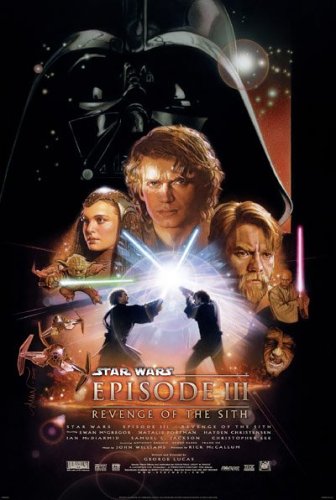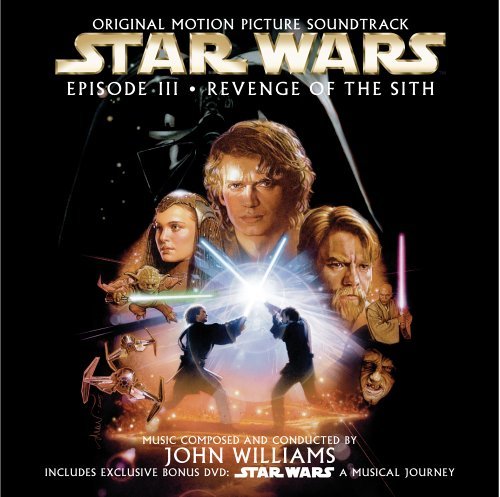
5/19/05 Edition
Special
STAR WARS Edition
Andy's Review of EPISODE
III: REVENGE OF THE SITH
Plus:
A Look at Sony Classical's CD/DVD Soundtrack Package
And so it ends.

The galaxy far, far away that George Lucas introduced us to in 1977 --
back before we knew his new movie was actually “Episode
IV” and
subtitled “A New Hope” -- is given a glorious send
off in the climactic
STAR
WARS EPISODE III: REVENGE OF THE SITH (****),
a rollicking movie
matinee that ends the saga in the same deliriously entertaining manner
in which it began.
More confident in every way than its two predecessors (especially the
clunky “Attack of the Clones”), Episode III charts
the final downward
spiral of Anakin Skywalker, the last days of the Old Republic, the
demise of the Jedi Knights, the birth of Darth Vader and, separately,
his offspring that would one day lead to his ultimate redemption.
It’s a story any Star Wars fan knows the outline of, but
filling in the
details provides all the fun of Lucas’ final installment in
his sci-fi
fantasy series, which benefits from generally crisp pacing, rapid-fire
editing and some of the most exciting individual set-pieces of the
entire series.
While not without some faults of its own, “Revenge of the
Sith” is on
balance a substantially more satisfying picture than either of the
prequels. Carrying the acting load much of the way here is Ewan
McGregor, who gives a far more energetic and charismatic performance
as Obi-Wan Kenobi, watching helplessly as his young apprentice Anakin
(Hayden Christensen) gets wrapped up in the nefarious dealings of
Senator Palpatine (Ian McDiarmid). Utilizing Anakin’s
arrogance and
premonitions about the death of his wife Padme (Natalie Portman),
Palpatine exploits Skywalker’s frustration with his Jedi
teachers
(including Yoda and Samuel L. Jackson’s Mace Windu) and turns
his anger
to the dark side.
It’s a journey filled with great moments: a dizzying opening
aerial
combat sequence, a dynamic chase between Obi-Wan and the vile General
Grievous, light-saber battles galore and a sensational climax that
finally delivers the payload of goods fans expected of George Lucas
when he announced that the prequels would be made nearly a decade ago.
The leaden dialogue so prevalent in “The Phantom
Menace” and especially
“Attack of the Clones” does pop up here --
especially in the opening
half-hour -- but fortunately, it proves to be far less of a distraction
because Lucas’ air-tight script actually seems to know where
it’s going
and how it’s going to get there. The references to the
original trilogy
(which I guess we’ll now call the
“sequels”) aren’t heavy-handed,
either, but rather subtly handled and nicely incorporated into the
narrative and visual fabric of the film.
Though a perfect popcorn movie, “Revenge of the
Sith” somehow manages
to be suspenseful but seldom emotionally involving -- at least where
its lead character is concerned. I suppose it’s a byproduct
of the
entire prequel trilogy that even though we see Anakin and Padme
enduring a tragic succession of events in Episode III, somehow I never
became overly wrapped up in Anakin actually becoming Darth Vader.
Christensen here is certainly more effective than he was in Episode II,
yet I still never felt the spectrum of emotion in the character that
the material demands -- perhaps the result of a not entirely satisfying
performance and a script that didn’t support the actor as
much as it
should have.
Nevertheless, the only other fault I found in
“Sith” is also going to
be one of its more enduring elements for some audiences. Once
Palpatine’s villainous actions are uncovered, Ian
McDiarmid’s
appropriately bonkers performance absolutely goes for broke. Snarling,
seething, and topped off with Bela Lugosi-like glowing eyes,
McDiarmid’s Emperor manages to be more over-the-top and
dynamically
entertaining -- though also substantially less menacing -- than the
role as he performed it in “Return of the Jedi.”
Perhaps Lucas, sensing
that the material here was darker and more depressing than anything
else in the “Star Wars” galaxy, opted to play the
role with less of an
edge, since the only viewers who will be afraid of
McDiarmid’s
Palpatine/Lord Sidious/Emperor are likely to be youngsters under the
age of seven or eight.
What’s most satisfying about “Revenge of the
Sith” is -- surprisingly
enough -- its sense of fun. As strange as it may seem given the
well-hyped “dark” and “mature”
story line, Episode III is more playful
and engaging than its comparatively stiff predecessors. The actors seem
more comfortable, Lucas’ direction and editorial
cross-cutting never
misses a beat, and the storytelling is simply more cohesive.
The cherry on top comes at the end. After a gangbusters climax as
well-executed as anything in Lucas’ career,
“Sith” ties up the loose
ends of the “Star Wars” saga and does so in a
supremely effective
manner. No scene becomes too melodramatic or heavy-handed, overly
maudlin or saccharine. Ample emotion is generated in John
Williams’
score, the subtlety of how the material is presented, and the emotional
attachment viewers have with the original movies. Lucas the filmmaker
finally hits his stride as the series wraps up, leading us into the
story that picks up in the movies that he’s already made.
And, at long last, he’s finally produced a new work of his
own worthy of them. (PG-13, 146 mins.)
 Sony
Classical’s Soundtrack Release
Sony
Classical’s Soundtrack Release
Though I still feel that John Williams’ score for THE PHANTOM
MENACE is
the best of his prequel soundtracks (if only because of the terrific
new thematic material he scored for Episode I), make no mistake:
REVENGE
OF THE SITH is a superb,
operatic new work that easily
surpasses the comparatively disappointing score Williams produced for
Episode II, “Attack of the Clones” (a score that,
however much it puts
most modern film music to shame, still ranks as a letdown when viewed
against the rest of the Williams canon).
Marked by one driving, sensational new theme -- “Battle of
the Heroes”
-- that underscores the film’s furious climactic duel between
Obi-Wan
and Anakin, Williams here says goodbye to not just the prequels but the
“Star Wars” universe altogether. That means a
moving reprise of several
themes from the composer’s very first “Star
Wars” score, including the
motifs for Luke and Leia, tenderly -- and beautifully -- utilized at
the end of the film. He also weaves in reprisals of his finest prequel
themes, including “Duel of the Fates” (which will
undoubtedly go down
as the most memorable composition from the prequels) and his
“Across
the Stars” love theme (still too close to
“Hook” for my tastes). I was
somewhat surprised that Williams’ poignant
“Anakin’s Theme” from the
“The Phantom Menace” didn’t receive much
play here, particularly since
Williams brilliantly toyed with the “Imperial
March” in his original
arrangement of the composition. On the other hand, “The
Imperial March”
doesn’t receive a full statement in the series until
“The Empire
Strikes Back,” and Williams follows through here on that
chronology,
refraining from a full statement of the motif, even in tracks like
“Enter Lord Vader” (the theme does appear briefly,
but only for The
Emperor late in the movie).
When viewed solely as a soundtrack album, “Revenge of the
Sith”
provides a rich listening experience, a score backed by excellent use
of the London Voices Choir in addition to the standard, superlative
performance of the London Symphony. One constantly gets the impression
that we’re in a dense, more dramatic story than the preceding
films:
cues like “Palapatine’s Teachings” and
“Padme’s Ruminations” offer a
strikingly ominous tone that’s as dense as anything
you’ll find in the
“Star Wars” galaxy. On the other hand, Williams
takes George Lucas’
lead and uses the final moments to directly tie in with “A
New Hope,”
pointing to the light side of The Force that the twins represent, and
the eventual redemption they will also, one day, bring to their fallen
father.
There have been complaints among some listeners that there’s
too much
“A New Hope” in the final minutes of
“Sith,” that Williams could have
used the opportunity here to create more thematic material directly for
this film and not merely reprieved previous compositions. For me,
though, the “Episode III” soundtrack works because
of how effectively
Williams utilizes several of his classic themes. Instead of harkening
back to the fallen Anakin Skywalker, which obviously fueled the prequel
trilogy, Williams took the opportunity in the final minutes of
“Revenge
of the Sith” to light the way to the true, ultimate message
of the
“Star Wars” films, and the general optimism of the
original trilogy. As
Lucas points out in his liner notes, “the darkest time is
always before
the dawn,” and Williams follows that with a gentle, and
thoroughly
moving, use of Luke’s motif and “Princess
Leia’s Theme” before segueing
into the end credits. There, the composer bids adieu to six films that
will forever live on in movie history. His use of “The Throne
Room” is
Williams’ farewell to one of the cinema’s greatest
series, and after
scoring so many minutes of difficult music over a near-30 year span,
the composer has more than earned the right to finish off the saga
however he sees fit.
Needless to say, despite missing a few cues (I don’t believe
the
striking music heard directly after the opening crawl is anywhere on
the album), Williams’ score is certainly more than enough to
merit
recommending Sony Classical’s soundtrack release, but the
label has
sweetened the pot by also including a sensational DVD, STAR
WARS: A
MUSICAL JOURNEY.
This bonus extra (included at no extra charge as well) provides a
70-minute musical essay through Williams’ six series scores,
set to
often strikingly-edited clips from all of the “Star
Wars” films in 16:9
widescreen. Not only that, but the DVD offers an amazing 5.1 Dolby
Digital musical re-mix of all the cues -- courtesy of Shawn Murphy --
that surpasses even the “Special Edition” RCA/Sony
Classical CD
editions of the original trilogy in their depth and overall musical
detail. It’s enough to make your mouth water at thoughts of a
similar
remix for all the original scores (and who wants to bet
that’ll happen
with the 3-D reissues of the films in 2007?).
Ian MacDiarmid hosts the program, but one can do away with his
introductory segments if you so choose. The clips, meanwhile, directly
pertain to the cues being heard, wisely inter-cutting footage from the
original trilogy as well as the prequels, along with some
pre-production conceptual art by Ralph MacQuarrie among others.
It’s a dynamite extra that Sony could have used as leverage
to create a
more expensive “Limited Edition” CD, but give them
credit: it’s part of
the basic soundtrack package, priced no more or less than your average
CD. Bravo to the label for both its inclusion in the standard release,
and for doing a superlative job with a one-of-a-kind DVD extra.
Obviously a must for all “Star Wars” fans as we bid
our own fond
farewells to George Lucas’ galaxy....at least for now.
NEXT
TIME: Back with more reviews, comments and more! Don't
forget
to drop in and debate EPISODE III (or the new Varese CD Club releases)
on the Message
Boards, direct
any emails to the
link
above and
we'll catch you
then. Cheers!

VISITORS
TO ANDYFILM.COM






 Sony
Classical’s Soundtrack Release
Sony
Classical’s Soundtrack Release